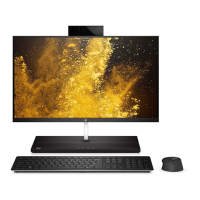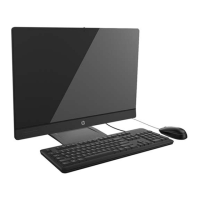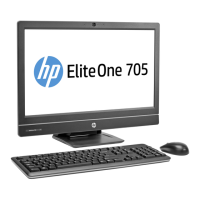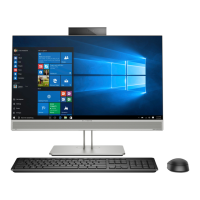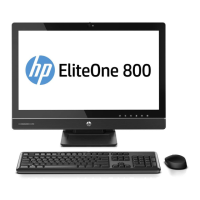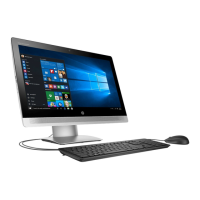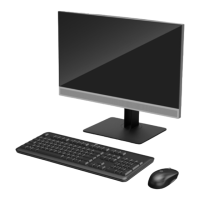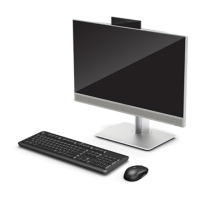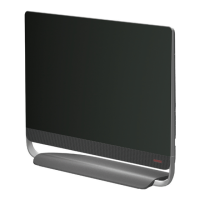Do you have a question about the HP EliteOne 1000 G1 and is the answer not in the manual?
Provides a general introduction to the HP EliteOne 1000 G1 Business PCs and its features.
Identifies and describes the components located on the top of the computer's base unit.
Identifies and describes the components located on the sides of the computer's base unit.
Identifies and describes the components located on the rear of the computer's base unit.
Identifies and describes the components located on the front of the display.
Details the components of the Infrared (IR) and Full High Definition (FHD) webcams.
Explains where to find the unique serial and product identification numbers on the device.
Provides essential information about preventing damage from electrostatic discharge (ESD).
Explains how different activities generate static electricity and its relation to humidity.
Outlines precautions for preventing damage to electronic components from ESD.
Describes equipment and methods for preventing static electricity damage.
Provides precautions for preventing static damage in the work area.
Lists recommended materials and equipment for preventing static electricity.
Provides guidelines to prevent overheating and prolong the computer's life.
Focuses on general maintenance and care procedures for the computer.
Lists crucial safety precautions to follow when cleaning the computer and its parts.
Provides step-by-step instructions for cleaning the computer's exterior case.
Details the procedure for cleaning the computer's keyboard.
Explains how to safely clean the computer's display screen and body.
Provides instructions for cleaning the computer mouse.
Lists important considerations for disassembly and assembly of the computer.
Specifies the necessary tools and software for servicing the computer.
Outlines essential steps to take before disassembling the computer for safety.
Describes how to remove and replace the computer's base unit access covers.
Details the procedure for removing and replacing the display head assembly.
Illustrates and identifies key internal components of the computer.
Provides specifications for memory modules and information on populating slots.
Explains the step-by-step process for installing or removing memory modules.
Describes the Real-Time Clock battery, its function, and replacement procedure.
Details the procedures for removing and installing the computer's hard drive.
Provides instructions for removing and replacing the computer's internal fans.
Explains the process for removing and installing an M.2 solid-state drive.
Describes how to remove the rear panel from the display head assembly.
Provides instructions for replacing the computer's integrated camera module.
Details the procedure for removing and replacing the Wireless LAN module.
Explains how to remove and replace the computer's internal speakers.
Describes the procedure for removing and replacing the computer's antenna cables.
Provides instructions for removing and replacing the computer's heat sink assembly.
Details the steps for removing and installing the computer's processor.
Explains the comprehensive procedure for removing and replacing the system board.
Provides a visual guide and labels for system board components.
Introduces the Computer Setup (F10) Utility and its capabilities.
Describes how to access and navigate the Computer Setup Utilities menu.
Details the options available within the Main section of Computer Setup.
Explains the security-related settings and password configurations in Computer Setup.
Covers advanced configuration options for system settings and boot behavior.
Provides instructions for saving and restoring computer configuration settings.
Guides on how to download and create HP PC Hardware Diagnostics UEFI on a USB drive.
Explains how to use Remote HP PC Hardware Diagnostics settings in Computer Setup.
Details how to customize settings for remote HP PC Hardware Diagnostics.
Provides warnings and guidance on maintaining a safe and comfortable work environment.
Offers preliminary troubleshooting steps to isolate problems before contacting support.
Provides general suggestions and tips for resolving computer or software issues.
Addresses common problems like computer not responding, incorrect date/time, or no sound.
Helps diagnose and resolve issues related to the computer not powering on or shutting down.
Provides solutions for issues such as hard disk errors, bad sectors, or drive not found.
Offers troubleshooting steps for audio issues like cuts in sound or no sound output.
Addresses issues where keyboard or mouse input is not recognized or responding.
Helps resolve problems encountered when installing new hardware devices.
Provides solutions for issues related to network connectivity and drivers.
Offers guidance for troubleshooting memory-related errors and performance issues.
Addresses issues with USB flash drives not being recognized or not booting.
Helps diagnose and resolve issues related to connecting to the internet.
Provides solutions for common software issues and system errors.
Explains how to create recovery media and backups for system restore.
Details how to use HP Recovery media to restore the system or create new media.
Describes how to use Windows tools for system restore points and backups.
Guides on creating HP Recovery media using the HP Cloud Recovery Download Tool.
Presents various options for restoring the computer to its original state.
Explains how to use HP Recovery Manager for system recovery.
Provides instructions on recovering the system using HP Recovery media.
Details how to modify the computer's boot order in BIOS.
Explains how to remove the HP Recovery partition to free up hard drive space.
Lists POST errors with numeric codes and text messages and their recommended actions.
Explains how to interpret diagnostic front panel LEDs and audible error codes.
Provides instructions for resetting or clearing administrator and power-on passwords.
Explains how to clear and reset BIOS settings to factory defaults.
Outlines the general requirements for power cord sets applicable to all countries.
Specifies the power cord requirements exclusively for use in Japan.
Details additional specific power cord requirements for various countries.
Provides steps to restore nonvolatile memory containing personal data.
Details the usage, purpose, and write-protection of various nonvolatile memory types.
Provides a general introduction to the HP EliteOne 1000 G1 Business PCs and its features.
Identifies and describes the components located on the top of the computer's base unit.
Identifies and describes the components located on the sides of the computer's base unit.
Identifies and describes the components located on the rear of the computer's base unit.
Identifies and describes the components located on the front of the display.
Details the components of the Infrared (IR) and Full High Definition (FHD) webcams.
Explains where to find the unique serial and product identification numbers on the device.
Provides essential information about preventing damage from electrostatic discharge (ESD).
Explains how different activities generate static electricity and its relation to humidity.
Outlines precautions for preventing damage to electronic components from ESD.
Describes equipment and methods for preventing static electricity damage.
Provides precautions for preventing static damage in the work area.
Lists recommended materials and equipment for preventing static electricity.
Provides guidelines to prevent overheating and prolong the computer's life.
Focuses on general maintenance and care procedures for the computer.
Lists crucial safety precautions to follow when cleaning the computer and its parts.
Provides step-by-step instructions for cleaning the computer's exterior case.
Details the procedure for cleaning the computer's keyboard.
Explains how to safely clean the computer's display screen and body.
Provides instructions for cleaning the computer mouse.
Lists important considerations for disassembly and assembly of the computer.
Specifies the necessary tools and software for servicing the computer.
Outlines essential steps to take before disassembling the computer for safety.
Describes how to remove and replace the computer's base unit access covers.
Details the procedure for removing and replacing the display head assembly.
Illustrates and identifies key internal components of the computer.
Provides specifications for memory modules and information on populating slots.
Explains the step-by-step process for installing or removing memory modules.
Describes the Real-Time Clock battery, its function, and replacement procedure.
Details the procedures for removing and installing the computer's hard drive.
Provides instructions for removing and replacing the computer's internal fans.
Explains the process for removing and installing an M.2 solid-state drive.
Describes how to remove the rear panel from the display head assembly.
Provides instructions for replacing the computer's integrated camera module.
Details the procedure for removing and replacing the Wireless LAN module.
Explains how to remove and replace the computer's internal speakers.
Describes the procedure for removing and replacing the computer's antenna cables.
Provides instructions for removing and replacing the computer's heat sink assembly.
Details the steps for removing and installing the computer's processor.
Explains the comprehensive procedure for removing and replacing the system board.
Provides a visual guide and labels for system board components.
Introduces the Computer Setup (F10) Utility and its capabilities.
Describes how to access and navigate the Computer Setup Utilities menu.
Details the options available within the Main section of Computer Setup.
Explains the security-related settings and password configurations in Computer Setup.
Covers advanced configuration options for system settings and boot behavior.
Provides instructions for saving and restoring computer configuration settings.
Guides on how to download and create HP PC Hardware Diagnostics UEFI on a USB drive.
Explains how to use Remote HP PC Hardware Diagnostics settings in Computer Setup.
Details how to customize settings for remote HP PC Hardware Diagnostics.
Provides warnings and guidance on maintaining a safe and comfortable work environment.
Offers preliminary troubleshooting steps to isolate problems before contacting support.
Provides general suggestions and tips for resolving computer or software issues.
Addresses common problems like computer not responding, incorrect date/time, or no sound.
Helps diagnose and resolve issues related to the computer not powering on or shutting down.
Provides solutions for issues such as hard disk errors, bad sectors, or drive not found.
Offers troubleshooting steps for audio issues like cuts in sound or no sound output.
Addresses issues where keyboard or mouse input is not recognized or responding.
Helps resolve problems encountered when installing new hardware devices.
Provides solutions for issues related to network connectivity and drivers.
Offers guidance for troubleshooting memory-related errors and performance issues.
Addresses issues with USB flash drives not being recognized or not booting.
Helps diagnose and resolve issues related to connecting to the internet.
Provides solutions for common software issues and system errors.
Explains how to create recovery media and backups for system restore.
Details how to use HP Recovery media to restore the system or create new media.
Describes how to use Windows tools for system restore points and backups.
Guides on creating HP Recovery media using the HP Cloud Recovery Download Tool.
Presents various options for restoring the computer to its original state.
Explains how to use HP Recovery Manager for system recovery.
Provides instructions on recovering the system using HP Recovery media.
Details how to modify the computer's boot order in BIOS.
Explains how to remove the HP Recovery partition to free up hard drive space.
Lists POST errors with numeric codes and text messages and their recommended actions.
Explains how to interpret diagnostic front panel LEDs and audible error codes.
Provides instructions for resetting or clearing administrator and power-on passwords.
Explains how to clear and reset BIOS settings to factory defaults.
Outlines the general requirements for power cord sets applicable to all countries.
Specifies the power cord requirements exclusively for use in Japan.
Details additional specific power cord requirements for various countries.
Provides steps to restore nonvolatile memory containing personal data.
Details the usage, purpose, and write-protection of various nonvolatile memory types.
| Screen shape | Flat |
|---|---|
| LED backlight | Yes |
| Display diagonal | 27 \ |
| Tilt angle range | -5 - 25 ° |
| Native aspect ratio | 16:9 |
| Product color | Black, Silver |
| Country of origin | China |
| Product type | All-in-One PC |
| Motherboard chipset | Intel® Q270 |
| Bus type | DMI3 |
| Stepping | B0 |
| Tjunction | 100 °C |
| Processor code | SR335 |
| Processor cache | 6 MB |
| Processor cores | 4 |
| Processor model | i5-7500 |
| System bus rate | 8 GT/s |
| Processor family | Intel® Core™ i5 |
| Processor series | Intel Core i5-7500 Desktop Series |
| Processor socket | LGA 1151 (Socket H4) |
| Processor codename | Kaby Lake |
| Number of QPI links | 0 |
| Processor frequency | 3.4 GHz |
| Processor cache type | Smart Cache |
| Processor lithography | 14 nm |
| Processor manufacturer | Intel |
| PCI Express slots version | 3.0 |
| Processor boost frequency | 3.8 GHz |
| Processor operating modes | 64-bit |
| PCI Express configurations | 1x16, 1x8+2x4, 2x8 |
| Thermal Design Power (TDP) | 65 W |
| Maximum number of PCI Express lanes | 16 |
| Memory types supported by processor | DDR3L-SDRAM, DDR4-SDRAM |
| Memory voltage supported by processor | 1.35 V |
| Memory channels supported by processor | Dual |
| Memory clock speeds supported by processor | 1333, 1600, 2133, 2400 MHz |
| Maximum internal memory supported by processor | 64 GB |
| Memory slots | 2 |
| Internal memory | 8 GB |
| Memory slots type | SO-DIMM |
| Memory clock speed | 2400 MHz |
| Internal memory type | DDR4-SDRAM |
| Maximum internal memory | 32 GB |
| Memory layout (slots x size) | 1 x 8 GB |
| SSD capacity | The Solid State Drive's storage capacity in Gigabytes. |
| SSD interface | PCI Express |
| Storage media | SSD |
| Total storage capacity | 256 GB |
| Compatible memory cards | Not supported |
| Number of SSDs installed | 1 |
| On-board graphics card ID | 5912 |
| Discrete graphics card model | Not available |
| On-board graphics card model | Intel® HD Graphics 630 |
| On-board graphics card OpenGL version | 4.4 |
| On-board graphics card base frequency | 350 MHz |
| On-board graphics card DirectX version | 12.0 |
| On-board graphics card dynamic frequency (max) | 1100 MHz |
| Number of displays supported (on-board graphics) | 3 |
| AC adapter power | 180 W |
| Total megapixels | 2 MP |
| Wi-Fi standards | Wi-Fi 5 (802.11ac) |
| Ethernet LAN data rates | 10, 100, 1000 Mbit/s |
| USB 2.0 ports quantity | USB 2.0 ports have a data transmission speed of 480 Mbps, and are backwards compatible with USB 1.1 ports. You can connect all kinds of peripheral devices to them. |
| Scalability | 1S |
| Processor ARK ID | 97123 |
| Processor package size | 37.5 x 37.5 mm |
| Supported instruction sets | AVX 2.0, SSE4.1, SSE4.2 |
| Thermal solution specification | PCG 2015C |
| Intel Identity Protection Technology version | 1.00 |
| HP Security tools | HP BIOSphere with Sure Start, HP Client Security Suite Gen 3, HP Power On Authentication, HP Password Manager |
| HP Management tools | HP Management Integration Kit for Microsoft System Center Configuration Management |
| HP Software provided | HP Hotkey Support, HP Noise Cancellation Software, HP PhoneWise, HP SureConnect, HP Velocity, HP Secure Erase, HP Sure Click |
| Depth (with stand) | 190 mm |
|---|---|
| Width (with stand) | 613.3 mm |
| Height (with stand) | 457.3 mm |
| Weight (with stand) | 10200 g |
